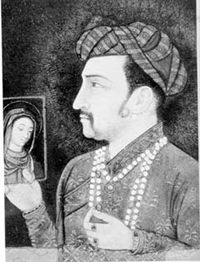
The Emperor Jahangir examining a picture. Mughal miniature, 17th century. Click image for a larger view.
Jahangir was born on 9 September 1569 at Fatehpur Sikri. His father, Akbar, really doted on him but the relationship got bitter as Jahangir came of age. Jahangir openly rebelled against his father at first, but was evenutally reconciled; and on Akbar’s death in November 1605, he assumed the throne. Though his own son, Khusrau, then seventeen years old, led a military campaign against his father, Jahangir captured him and rendered him blind. In 1611, Jahangir met, wooed, and married Mehrunissa, the young widow of a Mughal officer. A beautiful and strong woman, she soon became Jahangir’s favorite queen and assumed the title of Nur Jahan, ‘Light of the World’. Her father, Itimad ñud-daulah, was elevated to the position of chief minister; her brother, Asaf Khan, became a nobleman at the court; and his daughter, Mumtaz Mahal, was married to Khurram (later Shah Jahan), Jahangir’s other son, in 1612. Nur Jahan herself came to exercise considerable influence over her husband, and Jahangir is said to have relied heavily on her advice.
Under Jahangir, the empire continued to be a war state attuned to conquest and expansion. Jahangir’s most irksome foe was the Rana of Mewar, Amar Singh, who finally capitulated in 1613 to Khurram’s forces. In the northeast , the Mughals clashed with the Ahoms of Burma, whose guerilla tactics gave the Mughals a hard time. In Northern India, Jahangir’s forces under Khurram defeated their other principal adversary, the Raja of Kangra, in 1615; in the Deccan, his victories further consolidated the empire. But in 1620, Jahangir fell sick, and so ensued the familiar quest for power. Nur Jahan married her daughter to Shahryar, Jahangir’s youngest son from his other queen, in the hope of having a living male heir to the throne when Jahangir died.
Jahangir always feared the Persians and the Uzbeks of Central Asia. The Persians matched the Mughals in military strength and resources. Their relations were tolerably good because each feared the other’s might. But in 1622, taking advantage of the disputes within the court, the Persians capitalized on the Mughals’ preoccupation in internal affairs and captured Qandahar. Shah Jahan refused to help Jahangir and Shahryar in the campaign against the Persians and thus led an open rebellion. He fought his fathers forces but was defeated and agreed to terms dictated by Nur Jahan. In 1627, Jahangir became seriously ill, and he never recovered from his illness. Upon the death of his father on 28 October 1627, Shah Jahan, with support from his father-in-law Asaf Khan, became the emperor by executing Shahryar and other male Mughal heirs. The accession of Shah Jahan to the throne was a result of great political intrigue.
Jahangir lacked the political enterprise of his father Akbar. But he was an honest man and a tolerant ruler. He strived to reform society and was tolerant towards Hindus, Christians and Jews. However, relations with Sikhs were strained, and the fifth of the ten Sikh gurus, Arjun Dev, was executed at Jahangir’s orders for giving aid and comfort to Khusrau, Jahangir’s rebellious son. Art, literature, and architecture prospered under Jahangir’s rule, and the Mughal gardens in Srinagar remain an enduring testimony to his artistic taste.

